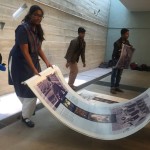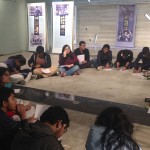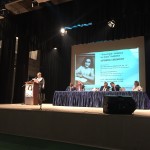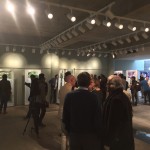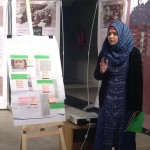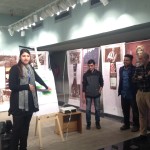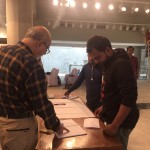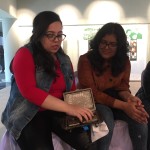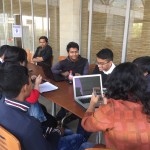Wednesday, 17 January 2018
On a cold winter morning, braving the infamous Dhaka traffic, Priya Machado and Loes Singels from Amsterdam and I, set out for the Liberation War Museum, where we would be setting up the exhibition Anne Frank – A History for Today and facilitating all the related education workshops.
Built to commemorate the soldiers and civilians who sacrificed their lives in the war that led to the creation of Bangladesh, the stark stone architecture evokes a sense of awe the moment you set eyes on the building. The eternal flame burning at the entrance with a huge well like structure going up all the way to the roof denotes victory and loss and suffering all at once. We could immediately sense from the outside that there could not have been a better setting to conduct a project on the holocaust, remembrance and human rights.
Day one had Peer Guide Training and the setup of the exhibition scheduled. We entered the gallery space to find a group of 18 students waiting eagerly to plunge into the day’s proceedings. Introductions were done with our favourite icebreaker—Show Your Best Dance Moves! The group was quite diverse with the age group ranging from 14 to 18, coming from private English medium schools and public Bengali medium schools. This would be my first of conducting workshops in English and Bengali simultaneously!
The students here were not as familiar with the Anne Frank Diary as we have found in India. But their enthusiasm and desire to absorb and learn was unparalleled! This is one workshop that has a standard format from which we usually do not deviate:
- Getting to know participants
- Explore how familiar they are with the story of Anne Frank
- Exhibition set up
- Circle time – discuss how they felt setting up the exhibition
- Break
- Study the panels
- Discuss responses and participant ideas on how they would guide visitors
- Ask participants to bring out keywords that they think are issues to be highlighted while guiding visitors
- Discuss our suggestions on how they could guide visitors
- Mock presentations
And yet, each group that we work with in different regions makes us feel we are facilitating the workshop for the first time with the extremely fresh perspectives they bring to the discussions.
The aim of this project is to educate students about human rights through the story of Anne Frank and develop critical thinking skills that enable them to connect historical events to current affairs thus keeping the core spirit behind Holocaust education—‘So that it never happens again’—alive. Often however we see many more outcomes from just a daylong session. In this case it was very heartening to see what seemed like the makings of life long friendships between students from very diverse backgrounds.
‘I cannot speak English the way they do but I have a lot of knowledge in my head’, said Yasin quietly to me at lunchtime. Just a little encouragement in response to his comment led to Yasin confidently and comfortably communicating with his peers in Bengali and leading the entire group throughout the post lunch sessions!
Thursday, 18 January 2018
Once the exhibition was setup we were ready to spend a day with teachers to demonstrate through hands on activities how the story of Anne Frank could be used for Human Rights education.
This was a small group of eleven, again from private and public schools. Small groups are always wonderful since they lead to more intense conversations. The workshop began with the teachers spending time viewing the exhibition. This was followed by each participant choosing a panel that made the deepest impression and sharing their insights with the group.
Next we explored various terms— ‘discrimination’, ‘prejudice’, ‘anti-Semitism’, ‘Holocaust’, Equality’—relating them to the Anne Frank story and to current events around the world.
Time flew and soon it was time for lunch.
The entire afternoon was spent on a group activity that explored connections and drew parallels between the Nazi decrees, articles of UDHR and headlines from local newspapers. Posters were made to present each group’s findings.
To end the day we discussed how the story of Anne Frank could be brought into the classroom and made relevant to Bangladesh. Tariq Ali, Chairman of the museum, who was present briefly at the workshop, just then, informed us about the diary of Swati Chowdhury which is displayed at the museum. She was 12 years old during the Liberation War and her diary, much like Anne Frank’s, records the daily trials and tribulations of her family and her community at the time.
The PeaceWorks Human Rights Teacher Resource was presented to the group and certificates distributed to mark the close of a very enriching and fruitful daylong session.
Friday, 19 January 2018
Sitting at my desk in Calcutta and planning the entire project over Skype meetings with Loes and Priya in Amsterdam was quite stress free and smooth. Except for one part—the Memory Walk workshop. To begin with the three day workshop had to be compressed one day; Neither Priya nor Loes, nor I had ever conducted this workshop before and most important, we were told to conduct it within the museum premises as against going out to explore monuments. The only issue working for me was knowledge of the region’s history!
With great trepidation we had planned some sort of a structure, which included requesting the participants to bring material objects of memory that may relate to their family’s experiences during the war.
One look at the museum though on day one had dispelled all doubts about how to conduct this workshop. The museum has a wealth of collection, beautifully curated, that tells several stories all at once. On hindsight we could conduct a Memory Walk workshop at the museum every month and not run out of content!
For this first one we picked three topics and divided the participants into three groups. The topics were:
- The role of women in the 1971 Liberation War
- Battle of Bellonia
- The Jeep [the museum houses a jeep used by the Pakistani army for Operation Searchlight]
The task included researching the content of the museum under the headings assigned to each group; interviewing visitors and staff to gather information; researching the internet for further background and information if required. At the end of the day all the information, knowledge and material gathered was to be presented to the entire group in the form of charts.
All of this was of course only assigned to the participants after spending the better half of the morning discussing ideas and concepts of Remembrance, Memorialization, Commemoration, the functions of memory, the types and forms of memory etc.
Each one of the participants was as interested in the theoretical aspect as the hands on task assigned to them. The first question that came our way was: Do we have to present in the form of charts? ‘Of course not’, we said, feel free to do your presentations in any medium you like’.
For the next two hours we did not see the students. When they were back we had one presentations in the form of a chart, one in the form of a photo essay and one was a film made on their phone!
‘Why can’t schools teach history like this!’ exclaimed one participant.
‘If I had studies history in this manner I would have certainly taken it up for higher studies’ said another.
For us these responses were very gratifying and there couldn’t have been a better way to conclude the workshop.
Saturday, 20 January 2018
Workshops and trainings all concluded, it was time for the official opening of the Anne Frank – A History for Today exhibition.
A grand affair by any standards the programme consisted of :
- Welcome and introduction to the program by Mr Tariq Ali, Liberation War Museum
- Screening of film: Stand in line for Anne Frank House
- A few words by Ms Priya Machado, Anne Frank House, Amsterdam
- A few words by Ms. Leoni Cuelenaere, Ambassador of the Kingdom of the Netherlands to Bangladesh
- Reading from the Anne Frank Diary in English and in Bengali by two students selected by us
- Lightning of the candles by students
- A few words by Dr. Khondoker Bazlul Hoque, Chairman Counter Foto Dhaka
- A few words by Mr. Mohammed Belal, Ambassador of Bangladesh in The Netherlands
- A few words by Mr. Abul Hassan Mahmood Ali, Honorable Foreign Minister of Bangladesh
After all these ‘few words’ to an audience of over 300, the exhibition was inaugurated by the Honorable Minister of Foreign Affairs and the Ambassador of the Kingdom of the Netherlands to Bangladesh and the peer guides got their first opportunity to display their newly acquired guiding skills to the illustrious visitors.
– Meena Malhotra

